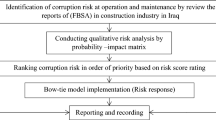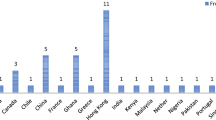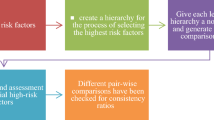Abstract
Corruption is an old phenomenon, but what is new is the increase in its scale and its diversified methods. Both advanced and developing countries have suffered to the point where corruption threatens to degrade communities and interrupt the progress of economic development. There are common issues in corruption, which is defined as the illegal obtainment of money, and the problem of corruption has been exacerbated by state institutions’ dealings with private-sector companies through contracts. The major aim of this study is to assess the practices of corruption that represent risks in the Iraqi construction sector. The analytic hierarchy process (AHP) was used to develop multi-criteria decision-making support models to compare the major factors and risk categories to discern those with the greatest negative effect on construction projects and then to specify the optimal actions for the prevention of such practices. A set of corruption practices were extracted through reviewing the literature from previous studies, the reports of the Federal Board of Supreme Audit (FBSA) in Iraq and interviews with experts and decision-makers in the FBSA. The corruption practices were evaluated using a form prepared to suit the AHP methodology and enforcement steps have been simplified through Super Decisions software, which was available for its fulfillment. The AHP analysis showed that the construction stage is the primary stage for corruption practices, followed by the tendering stage and then the design stage. This paper suggests preventive actions for practices at each stage of a construction project in Iraq, and it recommends multiple strategies to eliminate corruption.






Similar content being viewed by others
References
Adnan, H., Kassim, A., & Chong, H. Y. (2012). Success factors on joint venture projects for Indigenuous bumiputera contractors in Malaysia. Journal of Applied Sciences Research, 8, 4113–4125.
Akinsola, O. E., & Omolayo, O. H. (2013). Corruption and fraud in the Nigerian construction sector. The transformation of the building industry-possibilities and realities. 43 Rd Annual General Meeting and Conference of Nigeria Institute of Building Held at Conference Centre On, 26
Al Barqouni, H. M. (2015). Application of analytic hierarchy process (AHP) in risk assessment for construction building projects. A Thesis Submitted in Partial Fulfillment of Requirements for the Degree of Master in Construction Management, The Islamic University. Gaza
Albayrak, E., & Erensal, Y. C. (2004). Using analytic hierarchy process (AHP) to improve human performance: an application of multiple criteria decision making problem. Journal of Intelligent Manufacturing, 15(4), 491–503.
Al-Frijawy, J., Militaru, C., & Ali, M. H. (2018). The phenomenon of the spread of administrative and financial corruption in Iraq despite the multiplicity of oversight bodies. American Scientific Research Journal for Engineering Technology, and Sciences (ASRJETS), 49(1), 8–18.
Al-Harbi, K. M. A. S. (2001). Application of the AHP in project management. International Journal of Project Management, 19(1), 19–27.
Atanasova-Pacemska, T., Lapevski, M., & Timovski, R. (2014). Analytical hierarchical process (AHP) method application in the process of selection and evaluation
Baby, S. (2013). AHP modeling for multi-criteria decision-making and to optimise strategies for protecting coastal landscape resources. International Journal of Innovation, Management and Technology, 4(2), 218.
Borajee, M., & Yakchali, S. H. (2011). Using the AHP-ELECTRE III integrated method in a competitive profile matrix. International Conference on Financial Management and Economics (pp. 68–72)
Bowen, P., Edwards, P., & Cattell, K. (2012). Corruption in the South African construction industry: A mixed methods study. Proceedings of 28th Annual ARCOM Conference (Ed. Smith, SD), (pp. 521–531)
Bowen, P., Pearl, R., & Akintoye, A. (2007). Professional ethics in the South African construction industry. Building Research and Information, 35(2), 189–205.
Brown, J., & Loosemore, M. (2015). Behavioural factors influencing corrupt action in the Australian construction industry. Engineering, Construction and Architectural Management, 22(4), 372–389.
Chan, A. P. C., & Owusu, E. K. (2017). Corruption forms in the construction industry: literature review. Journal of Construction Engineering and Management, 143(8), 4017057.
Crist, R. A. (2009). The ASCE committee of global principles for professional conduct. Leadership and Management in Engineering, 9(3), 144–146.
Dağdeviren, M., Yavuz, S., & Kılınç, N. (2009). Weapon selection using the AHP and TOPSIS methods under fuzzy environment. Expert Systems with Applications, 36(4), 8143–8151.
Davis, J. (2004). Corruption in public service delivery: experience from South Asia’s water and sanitation sector. World Development, 32(1), 53–71.
De Jong, M., Henry, W. P., & Stansbury, N. (2009). Eliminating corruption in our engineering/construction industry. Leadership and Management in Engineering, 9(3), 105–111.
Dyer, R., & Forman, E. (1990). Analytical approach to marketing decisions (p. 496). Princeton.
Erasmus, J. (2013). Understanding tender corruption (pp. 1–17). Corruption Watch.
Eskander, R. F. A. (2018). Risk assessment influencing factors for Arabian construction projects using analytic hierarchy process. Alexandria Engineering Journal, 57(4), 4207–4218.
Foster, J. E., Horowitz, A. W., & Méndez, F. (2012). An axiomatic approach to the measurement of corruption: theory and applications. The World Bank Economic Review, 26(2), 217–235.
Fukuyama, F. (2005). Global corruption report: Corruption in construction and post-conflict reconstruction, transparency international. Auflage.
Gates, K. L. (2014). Biggest risk of corruption in the construction industry. The Global Picture, 11, 1–4.
Gunduz, M., Onder, O. (2012). Fraud and corruption risk assessment in construction industry, Las Vegas, Nevada USA, September 11–13, 2012.
Hadiwattege, C., De Silva, L., & Pathirage, C. (2000). Corruption in Sri Lankan Construction Industry. W107-Special Track 18th CIB World Building Congress May 2010 Salford, United Kingdom, 141
Hawkins, J. (2013). How to note: Reducing corruption in infrastructure sectors. Conference Paper.
Johnsøn, J. (2015). The basics of corruption risk management: A framework for decision making and integration into the project cycles. U4 Issue, 11(18), 1–23
Kasimu, M. A., & Kolawole, A. F. (2015). Appraisal of the impact of corruption on sustainable development in Nigerian Construction Industry. Journal of Multidisciplinary Engineering Science and Technology (JMEST)., 2(10), 2834–2842.
Keifer, G., & Effenberger, F. (1967). Understanding tender corruption. Angewandte Chemie International Edition, 6(11), 951–952.
Kenny, C. (2012). Publishing construction contracts to improve efficiency and governance. Proceedings of the Institution of Civil Engineers, 165(5), 18–22.
Kolawole, A. F. (2015). Appraisal of the impact of corruption on sustainable development in Nigerian Construction Industry. Journal of Multidisciplinary Engineering Science and Technology, 2(10), 2834–2842.
Mazigo, D. (2014). “Causes of corruption in construction public procurement in Tanzania: A case of Manyara Region” Dissertation Submitted in Partial Fulfillment of the Requirements for the Award of Master of Business Administration (Corporate Management) Degree of Mzumbe University
Mota-Sanchez, F. (2010). Application of analytic hierarchy process in upstream risk assessment and project evaluations, Ph.D. Thesis, Texas A & M University
Nag, B. (2015). Combating corruption in Indian public procurement: some exploratory case Studies. Journal of Institute of Public Enterprise, 38(1/2), 1–34.
OECD. (2016). Preventing corruption in public procurement. OECD.
Okafor, E. E. (2013). Corruption and implications for industrial development in Nigeria. Journal of Business Management, 7(29), 2916–2924.
Olufemi, A., Fniob, E., & Omolayo, O. H. (2013). Corruption and fraud in the Nigerian construction sector” A paper presented at the Transformation of the Building Industry–Possibilities and Realities. 43rd Annual General Meeting and Conference of Nigerian Institute of Building Held at International Conference Centre on 26th–30th
Plaček, M., Půček, M., & Ochrana, F. (2019). Identifying corruption risk: a comparison of Bulgaria and the Czech Republic. Journal of Comparative Policy Analysis: Research and Practice, 21(4), 366–384.
Podvezko, V. (2009). Application of AHP technique. Journal of Business Economics and Management, 2, 181–189.
Saaty, T. L. (1990). How to make a decision: the analytic hierarchy process. European Journal of Operational Research, 48(1), 9–26.
Saaty, T. L. (1996). Decision making with dependence and feedback: The analytic network process, vol. 4922. RWS Publications.
Saaty, T. L. (2008). Decision making with the analytic hierarchy process. International Journal of Services Sciences, 1(1), 83–98.
Saaty, T. L., & Hu, G. (1998). Ranking by eigenvector versus other methods in the analytic hierarchy process. Applied Mathematics Letters, 11(4), 121–125.
Saaty, T. L., & Vargas, L. G. (1991). Prediction, projection and forecasting: Applications of the analytic hierarchy process in economics, finance politics, games and sports. Kluwer Academic.
Saim, N. A. I. M., Rahman, I. A., & Ismail, M. F. (2018). Factors contributing to fraudulent practices in construction project life cycle. International Journal of Engineering & Technology, 7(3.20), 647–651.
Sevkli, M., Lenny Koh, S. C., Zaim, S., Demirbag, M., & Tatoglu, E. (2007). An application of data envelopment analytic hierarchy process for supplier selection: a case study of BEKO in Turkey. International Journal of Production Research, 45(9), 1973–2003.
Shakantu, W. (2006). Corruption in the construction industry: forms, susceptibility and possible solutions issues. Civil Engineering Siviele Ingenieurswese, 2006(7), 43–47.
Shan, M., Chan, A. P. C., Le, Y., Xia, B., & Hu, Y. (2015). Measuring corruption in public construction projects in China. Journal of Professional Issues in Engineering Education and Practice, 141(4), 5015001.
Shan, M., Le, Y., Chan, A., Hu, Y. (2020). Corruption in the public construction sector. ISBN 978-981-13-9550-5 (eBook). https://doi.org/10.1007/978-981-13-9550-5
Shan, M., Le, Y., Yiu, K. T., Chan, A. P., & Hu, Y. (2017). Investigating the underlying factors of corruption in the public construction sector: evidence from China. Science and Engineering Ethics, 23(6), 1643–1666.
Shan, M., Le, Y., Yiu, K. T. W., Chan, A. P. C., Hu, Y., & Zhou, Y. (2018). Assessing collusion risks in managing construction projects using artificial neural network. Technological and Economic Development of Economy, 24(5), 2003–2025. https://doi.org/10.3846/20294913.2017.1303648
Skibniewski, M. J., & Chao, L. C. (1992). Evaluation of advanced construction technology with AHP method. Journal of Construction Engineering and Management, 118(3), 577–593.
Škrbec J. (2016) “Corruption Risk Management” Addendum to the Risk Management Guidelines, handbook, this publication has been produced with the assistance of the European Union
Sohail, M., & Cavill, S. (2006). Corruption in construction projects. In: Serpell, A (Ed.), Proceedings of the CIB W107 Construction in Developing Countries Symposium Construction in Developing Economies: New Issues and Challenges, January, 18, 20
Sohail, M., & Cavill, S. (2008). Accountability to prevent corruption in construction projects. Journal of Construction Engineering and Management, 134(9), 729–738.
Tabish, S., & Jha, K. N. (2011). Analyses and evaluation of irregularities in public procurement in India. Construction Management and Economics, 29(3), 261–274.
Tabish, S. Z. S., & Jha, K. N. (2012). The impact of anti-corruption strategies on corruption free performance in public construction projects. Construction Management and Economics, 30(1), 21–35.
Tofan, A. S., & Breesam, H. K. (2018). Using the Fuzzy-AHP technique for determining the key performance indicators of public construction companies in Iraq. International Journal of Civil Engineering and Technology, 9(13), 1431–1445.
USAID. (2014). “Public Financial Management Risk Assessment Framework Manual” A mandatory Reference for ADS Chapter 20. https://www.usaid.gov/sites/default/files/documents/1868/220mae.pdf Accessed 28 Jul 2014.
Wang, J.-J., & Yang, D.-L. (2007). Using a hybrid multi-criteria decision aid method for information systems outsourcing. Computers & Operations Research, 34(12), 3691–3700.
Wen-Ying, L. I. (2009). Application of AHP analysis in risk management of engineering projects. Journal Beijing University of Chemical Technology (social Sciences Edition), 1, 46–48.
Wind, Y., & Saaty, T. L. (1980). Marketing applications of the analytic hierarchy process. Management Science, 26(7), 641–658.
World Bank. (2013). World development report 2014: Risk and opportunity-managing risk for development. The World Bank.
Zou, P. X. W. (2006). Strategies for minimizing corruption in the construction industry in China. Journal of Construction in Developing Countries, 11(2), 15–29.
Acknowledgements
This paper was produced in cooperation with the Department of Civil Engineering, University of Baghdad.
Author information
Authors and Affiliations
Corresponding author
Additional information
Publisher's Note
Springer Nature remains neutral with regard to jurisdictional claims in published maps and institutional affiliations.
Rights and permissions
About this article
Cite this article
Alani, S.H.N., Mahjoob, A.M.R. Using AHP to prioritize the corruption risk practices in the Iraqi construction sector. Asian J Civ Eng 22, 1281–1299 (2021). https://doi.org/10.1007/s42107-021-00381-0
Received:
Accepted:
Published:
Issue Date:
DOI: https://doi.org/10.1007/s42107-021-00381-0




